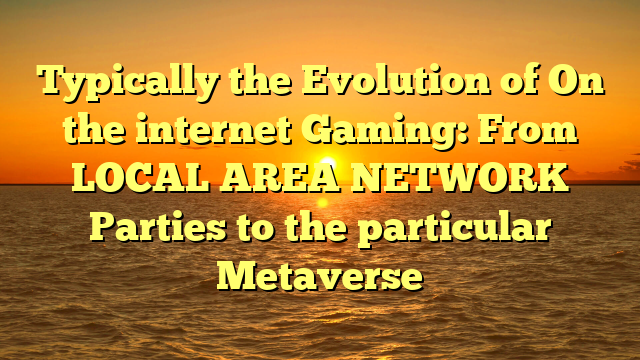Introduction
On the internet gaming has undergone an amazing transformation over the past many years. What began as easy multiplayer experiences in local area networks (LANs) has increased dramatically into a vast, interconnected universe where participants from around the particular globe can communicate, compete, and collaborate in real-time. This particular evolution has not necessarily only changed how we play games but also how all of us socialize, compete, in addition to even perceive virtual worlds. On this page, all of us explore the voyage of online game playing, its current scenery, and what the future holds.
The Early Days: LAN Parties and Basic Multi-player
Back in the 20th hundred years, online gaming has been a niche pastime primarily confined to enthusiasts who hosted LAN parties. These events involved connecting several computers within a local network to try out games like Doom, Go pitapat, and StarCraft. Although limited by technological innovation, these events fostered strong communities plus laid the foot work for future innovations in multiplayer video gaming.
The Rise regarding Broadband and On the internet Platforms
The creation of broadband internet within the early 2000s was a game-changer. It enabled extra stable and quicker connections, making genuine online multiplayer activities feasible. Platforms just like Xbox Live in addition to PlayStation Network come about, providing centralized hubs for gamers in order to connect, compete, and communicate. Simultaneously, COMPUTER halimtoto saw the particular rise of companies like Steam, which often not only provided game distribution but in addition integrated multiplayer benefits, achievements, and neighborhood features.
Massively Multi-player Online Games (MMOs) Take Center Phase
The mid-2000s witnessed the explosion associated with Massively Multiplayer On the web (MMO) games. Titles like Wow, EVENT Online, and Guild Wars created continual virtual worlds where thousands of players could interact together. These games emphasized long-term engagement, interpersonal interaction, and complicated economies, setting innovative standards for just what online games could obtain.
The current Landscape: Esports, Mobile Gaming, and Social Integration
Right now, online gaming encompasses a diverse array of genres and platforms. Esports has transformed competitive video gaming into an international phenomenon, with qualified players, large-scale tournaments, and substantial winning prize pools. Mobile gaming has democratized access, allowing millions to play anywhere, anytime. Additionally, social features such as tone of voice chat, streaming integrations, and in-game social support systems have made gaming a more immersive and interactive experience.
Seeking Ahead: The Metaverse and Beyond
The future of on-line gaming is connected with the idea of the metaverse—a collective virtual distributed space integrating increased reality (AR), digital reality (VR), and persistent online environments. Businesses like Epic Game titles, Roblox, and Facebook or myspace (Meta) are making an investment heavily in creating expansive, interconnected virtual worlds where gambling is just a single facet of a much wider digital existence. Developments in AI, fog up computing, and 5G technology will further enhance these experience, making the line involving the virtual in addition to real worlds increasingly blurred.
Conclusion
By humble beginnings in local networks in order to the expansive, connected with each other metaverse of these days, online gaming features continually evolved, led by technological breakthroughs and the unyielding creative imagination of developers plus players alike. As we check out typically the future, the potential for online games seems boundless, guaranteeing even more stunning, interactive, and socially rich experiences with regard to gamers around the particular world.
Typically the Evolution of On the internet Gaming: From LOCAL AREA NETWORK Parties to the particular Metaverse










